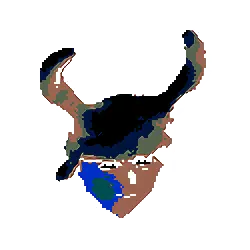Wouldn’t raising the legal limit for radioactive cesium in fish fix the problem?
🫵 My Corporate-sponsored Government Leaders wants YOU 🫵
My opinions are a great investment to increase your company’s profits. We can work on a individual project basis, or work with my team to setup a retainer for the best value and access to my opinions when you need them.
As long as I get rich without trying.
Remember: this is in the ecosystem. It directly affects every living thing in the region, including humans. People living there are getting fucked over just by existing there, and it is spreading outward with no possible means of containment. This goes far beyond just fish or some import drama with China, this is an ecological fucking nightmare.
And history has shown that humans are really bad at measuring the extent of ecological damage in general. In reality it’s probably way worse.
Absolutely, Japan created a huge ecological disaster here. Fun fact about the whole thing is that this type of reactor was known to be unsafe even back in the 70s, and one of the scientists from GE actually quit in protest over it https://abcnews.go.com/Blotter/fukushima-mark-nuclear-reactor-design-caused-ge-scientist/story?id=13141287
So, this isn’t even a problem with a danger of using nuclear power, but rather one with capitalists cutting corners while chasing profits.
Nuclear power is like skydiving. If getting it right every time isn’t something you’re committed to doing, then don’t do it.
Great potential in it to save the world, equal potential to destroy the world. Add on capitalist profit chasing and you’ve tipped the scales.
Also I’d just like to say this because I don’t think a lot of people know it: The meltdown was not because the tsunami hit the reactor. It didn’t. It hit an unrelated power station that was powering the cooling system, a system that was already extremely controversial due to its completely un-failsafe design and reliance on an external, much more vulrnable power source. This was not an unavoidable act of god, this was completely preventable and a massive insult to injury in an already devastated region following the tsunami.
The diesel generator, required when grid power was lost, was at the lowest point of the reactor site. Its an incredible lack of planning.
And to add Chernobyl wasn’t due to a spontaneous failure, it was a deliberate shutting down of backup systems to test them by people who didn’t plan it properly.
So what’s the conclusion as to what’s happening?
As I wrote about in a thread a couple weeks back (here, here, and here), this should have been fine, and was fine on paper.
According to official statements it was going to be diluted, before release, to a level that was even lower than what Fukushima NPP put out while operational. Then it was going to be released at a rate that maintained this concentration.
Did Japan lie? Did it not dilute how it said it would? Was it a technical failure and dilution did not occur at the level they said it would, or was it released too fast at the dilution level they set? Was there not testing at release time/site?
This article is not clear. I’m not sure if this issue is directly related to the planned waste water release since that hasn’t happened yet. Here’s a few scenarios off the top of my head:
-
Ground & rainwater continue to seep into the power plant and become contaminated. Maybe some of this water is not collected and instead flows out into the breakwater, continuously carrying additional contamination with it. In this case the release or non-release of the separately stored & treated water is not related to this issue.
-
The stored water is leaking out and contaminating the breakwater area. In this case the contamination could indicate that releasing this water is a bad idea because it will release more Cs contamination. Or maybe not, because I don’t think the currently stored water has been treated yet for release. The treatment plans for the stored water includes filtering out Cs.
-
The contamination in the breakwater is leftover from the initial disaster a decade ago and not new. Cs-137 has a half life of ~30 years, so most of it would still be around and it’s known that a lot of this stuff got into the seabed sediment in the area. In this case it again would not be an indication about anything related to the planned water release.
-
Some other scenario.
Unfortunately there’s just not enough information in this article to say for certain what the origin of the Cs contamination is and what consequences that holds.
-
So it wasn’t safe after all.
I remember there was one troll who kept arguing with me that China refusing to import radioactive fish was doing it as a political game as opposed to protecting people in China. That bullshit sure aged like milk.
Or like baby formula
deleted by creator
Yeah, I was thinking about that, too, but didn’t remember the specifics so I didn’t comment on the topic. Pour a glass of crusted milk to that fine gentletroll.
deleted by creator
We probably should measure around France too, they seem to release 500 times the amount of water to the sea https://www.cn.emb-japan.go.jp/files/100194021.pdf
A total of 44 fish with cesium levels above 100 becquerels per kg have been found in the Fukushima plant port between May 2022 and May 2023, Tepco confirmed, with 90% of those caught in or near the inner breakwater.
Is the article really talking about 44 fish?
There is a difference between contaminated water, like in Fukushima, and regular non-contaminated cooling water. There should be no radioactive contaminants in the water that the French nuclear power plants release.
Well actually cooling water is bombarded with neutrons, which transforms hydrogen atoms into deuterium and radioactive tritium. It’s just generally regarded as harmless (probably because there’s no good way to test for bioaccumulation.)
Depends, I didn’t see the total number of fish sampled.
If it was 44 fish out of 44 sampled, than 100% being over the limit is significant.
If it was 44 fish out of 1000+, than not so much.
44 fish out of 1000+ might be extremely significant.
If we’re going to say “what is the likelihood of pulling up a fish with 180x cesium levels?” then the number 44/1000+ might seem like we should say “It’s not very significant.” And for some phenomena, that’s an okay assessment. It’s the same as 4.4/100+, which is a less than 5% chance. Of course, having a 5% chance of getting shot on the way to work is a bit high. It probably means your work is being in active combat.
You also have to measure downstream effect. If there were 44/1000 and 1000 was the average catch size, that means that for a single catch, 44 fish that I can only assume are poisonous or at least medically dangerous. How many people would those 44 fish serve? Could we expect 50-60 downstream deaths or cases of cancer? How many shipments of 1000 fish, with 44 having 180x cesium levels, are going to make their way into the coastal cities and food distribution in the area?
But even beyond all of that, you cannot look at a statistical number intended to characterize something like this and make an interpretation as to its significance without more data. In this case, the number we’re measuring significance against is “Out of x fish, how many do we expect to have 180x cesium?” If the answer is “40,” then 44 is likely not significant. If the answer is “less than 1,” then I suspect 44 is extremely significant. It’s multiple orders of magnitude from baseline, which means that something very very different and quite possibly unexpected and extremely bad is going on.
Basically - and I’m not accusing you of this in any way - some people will use this kind of non-analysis to deliberately mislead their readers about health or safety or environmental issues. It’s nothing against you, OP. It’s just that I taught and still sometimes teach this kind of thing, and I want to make sure that people are aware when they read this sort of thing.
The 1000+ number was just a random number. It was simply to highlight that the article never mentioned the total numbers sampled, just the total numbers found to have the high levels.
I don’t doubt it was 44 out of 44, or that 44 out of 1000 is a lot as well, it simply wasn’t the point that I was trying to make.
My point isn’t about 1000 or 10000. It’s that we shouldn’t make assumptions as to the interpretation of statistical characteristics without sufficient additional data.
Let me know if I’m wrong (certainly possible) but I feel like if we found ONE fish with 180 times the legal limit of radiation, it would warrant a closer look. 44 fish found in an area that had a nuclear disaster sounds like more than enough samples to raise concerns.
(And I don’t really know about France, but sure if there might be a problem there too, I vote we check that out too.)
Well maybe this will stop overfishing /s /s /s








